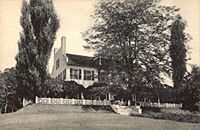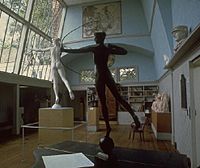Cornish, New Hampshire facts for kids
Quick facts for kids
Cornish, New Hampshire
|
|
|---|---|
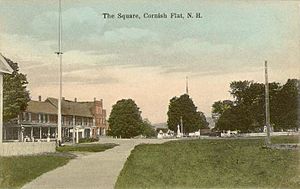
The Square in 1917
|
|
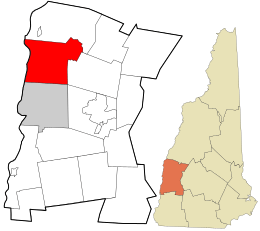
Location of Cornish in Sullivan County, New Hampshire and of Sullivan County in New Hampshire
|
|
| Country | United States |
| State | New Hampshire |
| County | Sullivan |
| Incorporated | 1765 |
| Villages |
|
| Area | |
| • Total | 42.6 sq mi (110.4 km2) |
| • Land | 42.0 sq mi (108.7 km2) |
| • Water | 0.7 sq mi (1.7 km2) 1.54% |
| Elevation | 466 ft (142 m) |
| Population
(2020)
|
|
| • Total | 1,616 |
| • Density | 39/sq mi (14.9/km2) |
| Time zone | UTC−5 (Eastern) |
| • Summer (DST) | UTC−4 (Eastern) |
| ZIP Codes |
03745 (Cornish)
03746 (Cornish Flat) |
| Area code(s) | 603 |
| FIPS code | 33-15060 |
| GNIS feature ID | 0873571 |
Cornish is a town located in Sullivan County, New Hampshire, in the United States. In 2020, about 1,616 people lived there. Cornish is special because it has four covered bridges. Every August, the town hosts the fun Cornish Fair.
Contents
History of Cornish

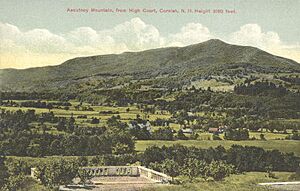
The town of Cornish was officially created in 1763. It was once known as "Mast Camp." This was a place where tall masts for ships were sent down the river by English settlers.
In 1765, colonial governor Benning Wentworth officially made Cornish a town. It was named after Sir Samuel Cornish, a famous admiral in the Royal Navy. Since 1827, Cornish has been part of Sullivan County.
Cornish Art Colony and Famous Residents
Starting in the late 1800s, Cornish became a popular summer spot for artists and writers. Sculptor Augustus Saint-Gaudens first came to Cornish in 1885. He was looking for a quiet studio away from the hot summer in New York City.
Many of his artist friends followed him. This included painter Maxfield Parrish, who built his home, "the Oaks," in the area. This group of artists and writers formed the famous Cornish Art Colony.
Cornish was also home to the author J. D. Salinger. He lived there from the 1950s until he passed away in 2010.
Longest Covered Bridge
Cornish is famous for its covered bridges. Until 2008, it had the longest covered bridge still standing in the United States. This was the Cornish–Windsor Covered Bridge. It crosses the Connecticut River and was built in 1866.
Today, Cornish is still home to the longest two-span covered bridge in the world. Besides the Cornish–Windsor Bridge, the town has three other covered bridges: the Blow-Me-Down Covered Bridge, Dingleton Hill Covered Bridge, and Kenyon Bridge.
Geography of Cornish
Cornish covers about 110.4 square kilometers (42.6 square miles). Most of this area is land, with a small part being water. The Connecticut River forms the western edge of the town. This river also marks the border between New Hampshire and Vermont.
Several brooks flow through Cornish and into the Connecticut River. These include Blow-me-down Brook, Mill Brook, and Walker Brook. Redwater Brook flows south to the Sugar River before joining the Connecticut.
Mountains and Forests
Along the eastern side of town is a long hill called Croydon Mountain. The highest point in Cornish is on Croydon Mountain, reaching about 708 meters (2,323 feet) above sea level.
A large private forest called the Blue Mountain Forest Association is in the eastern part of town. It's also known as Corbin Park. This area is a private game preserve, meaning it's a protected home for wild animals.
Villages and Roads
Cornish has several small villages within its borders. These include Cornish Center, Cornish Flat, Cornish City, Cornish Mills, South Cornish, Balloch, and Squag City.
Two main state roads, Route 12A and Route 120, pass through Cornish. These roads connect the town to Claremont in the south and Lebanon in the north.
Neighboring Towns
Cornish shares its borders with these nearby towns:
- Plainfield (to the north)
- Croydon (to the east)
- Claremont (to the south)
- Windsor, Vermont (to the west, across the Connecticut River)
Population Information
| Historical population | |||
|---|---|---|---|
| Census | Pop. | %± | |
| 1790 | 982 | — | |
| 1800 | 1,268 | 29.1% | |
| 1810 | 1,606 | 26.7% | |
| 1820 | 1,701 | 5.9% | |
| 1830 | 1,687 | −0.8% | |
| 1840 | 1,726 | 2.3% | |
| 1850 | 1,606 | −7.0% | |
| 1860 | 1,520 | −5.4% | |
| 1870 | 1,334 | −12.2% | |
| 1880 | 1,156 | −13.3% | |
| 1890 | 954 | −17.5% | |
| 1900 | 962 | 0.8% | |
| 1910 | 1,005 | 4.5% | |
| 1920 | 844 | −16.0% | |
| 1930 | 855 | 1.3% | |
| 1940 | 790 | −7.6% | |
| 1950 | 989 | 25.2% | |
| 1960 | 1,106 | 11.8% | |
| 1970 | 1,268 | 14.6% | |
| 1980 | 1,390 | 9.6% | |
| 1990 | 1,659 | 19.4% | |
| 2000 | 1,661 | 0.1% | |
| 2010 | 1,640 | −1.3% | |
| 2020 | 1,616 | −1.5% | |
| U.S. Decennial Census | |||
In 2020, the population of Cornish was 1,616 people. There were 761 housing units, and most of them (707) were lived in.
The average age of people in Cornish in 2000 was 42 years old. About 25.9% of the population was under 18 years old. About 12.2% of the population was 65 years or older.
Places to Visit in Cornish
- Balloch, New Hampshire
- Cornish Flat, New Hampshire
- Covered bridges:
- Saint-Gaudens National Historical Park
- New Hampshire Historical Marker No. 265: Cornish Meetinghouse
-
Aspet, home of Augustus Saint-Gaudens
-
Harlakenden House, built in Cornish, New Hampshire in 1898. It was a summer home for President Woodrow Wilson and burned down in 1923.
Famous People from Cornish
- Champion S. Chase (1820–1898), a politician.
- Dudley Chase (1771–1846), a U.S. senator from Vermont.
- Jonathan Chase (1732–1800), an officer in the Revolutionary War.
- Salmon P. Chase (1808–1873), a justice on the U.S. Supreme Court; he was born in Cornish.
- Winston Churchill (1871–1947), a novelist (not the British statesman).
- Herbert Croly (1869–1930), an author and co-founder of The New Republic magazine.
- Thomas Wilmer Dewing (1851–1938), a painter.
- Michael Dorris (1945–1997), a novelist and scholar.
- Julie Duncan (1919–1986), an actress and champion steeplechase rider.
- Louise Erdrich (born 1954), an author.
- Hamlin Garland (1860–1940), a novelist and poet known for stories about Midwestern farmers.
- James Hall (1802–1889), who founded Maryland-in-Africa.
- Learned Hand (1872–1961), a judge.
- Percy MacKaye (1875–1956), a playwright and poet.
- Charles A. Platt (1861–1933), an architect.
- Samuel L. Powers (1848–1929), a U.S. congressman.
- Augustus Saint-Gaudens (1848–1907), a famous sculptor.
- Louis St. Gaudens (1854–1913), an American sculptor and brother of Augustus Saint-Gaudens.
- J. D. Salinger (1919–2010), a writer, best known for his novel The Catcher in the Rye.
- Nathan Smith (1762–1829), a physician who founded medical schools at Dartmouth and Yale.
- Nathan Ryno Smith (1797–1877), a surgeon and professor, son of Nathan Smith.
- Betsey Ann Stearns (1830-1914), an inventor.
- Woodrow Wilson (1856–1924), a U.S. president who spent summers at Harlakenden House.
See also
 In Spanish: Cornish (Nuevo Hampshire) para niños
In Spanish: Cornish (Nuevo Hampshire) para niños


